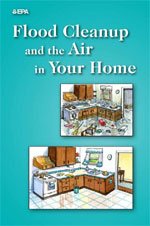Resources for Flood Cleanup and Indoor Air Quality
Información disponible en español
Flood water can make the air in your home unhealthy. This is because when things remain wet for more than two days, they usually get moldy. Inhaling mold can cause adverse health effects, including allergic reactions. Mold also can damage materials in your home. In addition, flood water may contain microorganisms, such as bacteria, or chemicals which may affect your health.
On this page:
- General Resources for Flood Cleanup and IAQ
- Technical Resources for Flood Cleanup and IAQ
- Additional Information on Floods and Hurricanes
On other pages:
Flood Cleanup to Protect Indoor Air and Your Health
General Resources for Flood Cleanup and IAQ
For basic information on how to clean up after a flood and how to prevent indoor air problems:
Flood Cleanup and Indoor Air Quality: Resource Summary

This resource summary provides an overview of available guidance and information on how to safely clean up your home and protect your indoor air quality following a flood. Simply scan the QR codes to access more detailed information.
Resources for Flood Cleanup and Indoor Air Quality (PDF)
Flooded Homes Cleanup Guidance

EPA’s Flooded Homes Cleanup Guidance provides a complete guide to cleaning up a home after a flood, including a series of brief how-to videos, infographics, and more.
Flooded Homes Cleanup Guidance | en Español
Flood Cleanup - Protecting Indoor Air Quality

This fact sheet contains basic information on flood cleanup with illustrations and links to more detailed information.
Fact Sheet: Flood Cleanup - Protecting Indoor Air Quality (PDF)
Homeowner's and Renter's Guide to Mold Cleanup after Disasters

This document was developed by EPA, Department of Housing and Urban Development (HUD), Federal Emergency Management Agency (FEMA), National Institutes of Health (NIH), the and Centers for Disease Control and Prevention (CDC). It summarizes basic procedures for mold remediation after flooding and other disasters.
Key Messages:
- Wear personal protective equipment. Wear an N-95 respirator at a minimum, goggles, and protective gloves.
- Use portable generators carefully, outside and away from the home, to avoid carbon monoxide poisoning and fires.
- Ensure the mold cleanup is complete before reoccupying your home.
This guide is available in two languages: English and Spanish
Flood Cleanup and the Air in Your Home: Booklet

This easy-to-read booklet tells you how to clean up after a flood and how to prevent indoor air problems with helpful illustrations.
Note: This 28-page booklet prints in landscape as a 15 page printout. Please set your printer to landscape before printing.
The booklet is available in three languages:
English Version EPA 402-K-07-002
Vietnamese Version EPA 402-K-06-006-VIE
Spanish Version
Flood Cleanup Infographic

This downloadable and printable PDF resource provides information on how to clean up after a flood and how to prevent indoor air problems with helpful illustrations.
The infographic is available as a:
Color Version and Grayscale Version
It is also available in several languages as a color version and grayscale version.
Technical Resources for Flood Cleanup and IAQ
Technical Report on Flood-Related Cleaning

This document addresses strategies for safely returning flooded buildings to habitable conditions after a hurricane or other weather event. It is a technical summary of existing research and guidance on health hazards from floods, flood damage, and cleanup activities. EPA’s Indoor Environments Division commissioned the report; however, it does not necessarily represent EPA policy.
Flood Cleanup Webinars Presented by Dr. Gene Cole
"Flood-Damaged Homes: Approaches to Effective Decontamination, Cleaning and Drying" Presented by Dr. Gene Cole
This is a recording of the April 18, 2019, technical assistance webinar Flood-Damaged Homes: Approaches to Effective Decontamination, Cleaning and Drying featuring Dr. Gene Cole and hosted by EPA’s Indoor Environments Division. In this webinar, Dr. Cole discussed safe and effective methods for remediating and restoring flood-damaged homes, with special emphasis on antimicrobial use, best practices for cleaning and drying, mold testing, and what to look for if you need professional assistance.
Flood Cleanup Webinar Presented by Dr. Gene Cole
This is a recording of the July 16, 2018, technical assistance webinar “Flood Cleanup” featuring Dr. Gene Cole and hosted by EPA’s Indoor Environments Division. Dr. Cole addressed many flood-related issues, including: specific remediation requirements for various types of water damage; use of biocides and personal protective equipment; best methods to reduce health and safety risks; and how to determine when remediation is complete.
Mold: Worker and Employer Guide to Hazards and Recommended Controls

This document was developed by EPA, Department of Housing and Urban Development (HUD), National Institutes of Health (NIH), and the Occupational and Safety and Health Administration (OSHA). The document summarizes basic procedures for mold remediation after flooding and other disasters with an emphasis on worker protection.
The guide is available in two languages:
